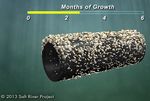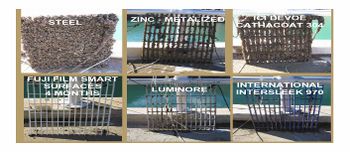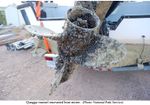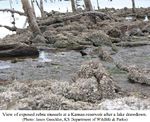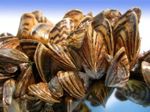|
Quagga mussels continue to be a major problem in the Colorado River. Since being discovered in Lake Mead in the Lower Colorado River in early 2007, the quagga mussels have spread rapidly in the watershed. Young mussels float in the water column and get carried by the water currents downstream, while adults attach themselves to the bottoms of boats and can be transported miles away. Quagga mussels, natives of Europe and Asia discovered in the Great Lakes region in the late 1980s, can grow to about 1.5 inches and are clogging water lines that are used to cool the 17 massive hydropower turbines at Hoover Dam. They have caused similar problems at the downstream Davis Dam in Lake Mohave and Parker Dam in Lake Havasu, both of which provide electricity for thousands of people in Arizona and California. Reclamation, which operates the Hoover, Davis and Parker dams, has employed divers with high-pressure water hoses to blow mussels out of pipelines and filter gates. But those treatments are expensive, and the results are only temporary.
"Mussels have the potential to disrupt water delivery and hydropower generation functions and to create long-term economic impacts...,"
"The risk of Dreissena establishing within the CRE is low, except for the Lees Ferry tailwater reach where the risk appears high. Dreissena are unlikely to establish at high densities within the CRE or its tributaries because of high suspended sediment, high ratios of suspended inorganic:organic material, and high water velocities, all of which interfere with the ability of Dreissena to effectively filter feed. The rapids of Grand Canyon may represent a large source of mortality to larval Dreissena, which would limit their ability to disperse and colonize downstream reaches of the CRE. In contrast, conditions within the Lees Ferry tailwater generally appear suitable for Dreissena establishment, with the exception of high average water velocity." [1]
|
